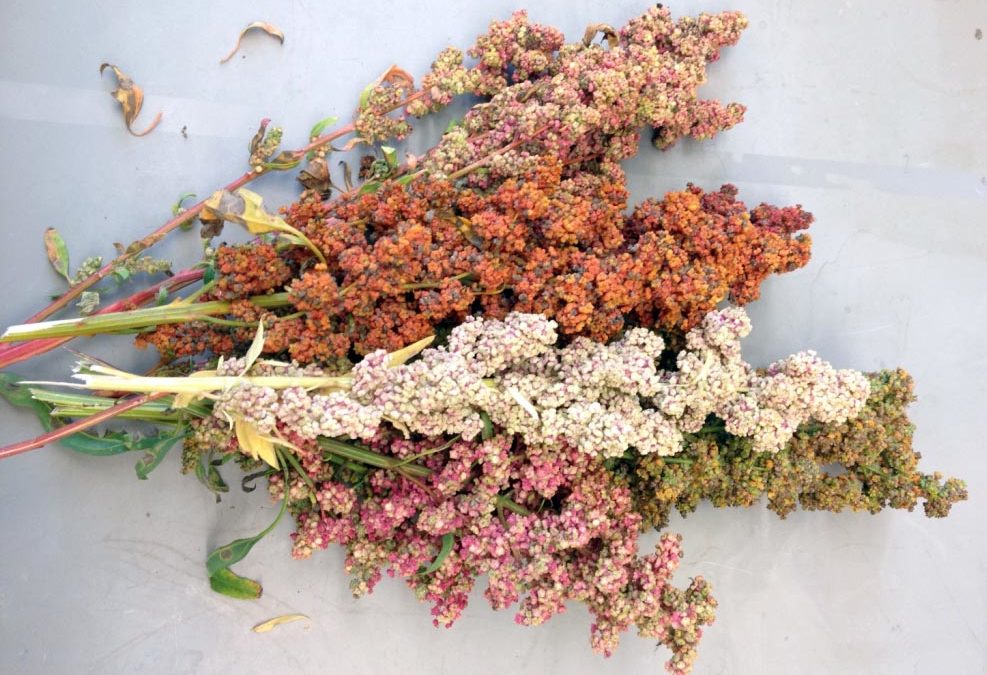By UNH News Service: Researchers with the New Hampshire Agricultural Experiment Station at the University of New Hampshire have launched a research project that aims to “re-domesticate” the superfood quinoa in Northern New England, giving the region’s farmers new high-value grain crop that is in high demand in the nation.
At the UNH Woodman Horticultural Research Farm, a facility of the NH Agricultural Experiment Station, researchers are investigating the potential use of a wild/weedy, locally adapted Chenopodium species as a breeding partner with quinoa in an effort to “re-domesticate” quinoa into a form suitable for crop production under Northern New England’s growing conditions.
“If we can successfully breed or re-domesticate a locally adapted quinoa variety that can be grown with commercial success, it would offer a new option to regional farmers interested in taking advantage of the current, very high price commanded by quinoa as a novel and highly nutritious grain crop,” said experiment station researcher and geneticist Tom Davis. Erin Neff, master’s student in integrative and organismal biology, also is working on the project.
According to the Food and Agricultural Organization of the United Nations, quinoa grain is a nutritional powerhouse that is high in protein, vitamins, and fiber, and low in fat. Quinoa is almost exclusively grown in South America, with the three main producing countries are Peru, Bolivia and Ecuador. However, its potential for cultivation elsewhere is being widely explored.
Global production of quinoa has been increasing significantly, surpassing 228 thousand metric tons in 2015, according to Statista. In 2014, the United States was the leading importer of quinoa in the world; U.S. quinoa imports totaled $159.12 million, or about 68.9 million pounds. The global price of quinoa has more than doubled from $2.96 per kilogram in 2010 to $6.74 per kilogram in 2014.
According to Davis, the plant genus Chenopodium includes the cultivated species, quinoa, and at least one problematic weed, lambsquarters, along with several other wild species in Northern New England and about 150 wild species worldwide. So far, researchers have documented the existence of four wild/weedy Chenopodium species in Northern New England, including the familiar lambsquarters as well as three others.
One of these, Chenopodium berlandieri, currently appears to be the most suitable breeding partner for quinoa. They also have confirmed that several existing, commercial quinoa varieties are challenging to grow successfully as a crop in Durham, and that the fungal disease downy mildew is one of the quinoa production challenges to be overcome by breeding.
“Existing quinoa varieties are adapted to regions with less humid fall seasons, and do not mature well here. However, some of quinoa’s weedy relatives are very successful and well-adapted as weeds in Northern New England,” Davis said.
So far, researchers have harvested seed from crosses performed during the past spring and early summer. Next they will germinate the seed to obtain seedling plants from which to isolate DNA needed to confirm whether the intended crosses have actually been accomplished. This summer they also are on the hunt for the elusive wild species, Chenopodium foggii, that has been reported in Northern New England. It has not been rigorously documented but could serve as a useful resource in their research.
“It is always a challenge to ‘get to know’ a new species chosen for study. We must learn how to grow the plants, how to perform genetic crosses, collect and germinate seed, differentiate among the wild species, and so on. It takes considerable time and effort to learn by doing,” Davis said.
“All of our major crop species are the evolutionary products of domestication processes occurring during the last 5,000 to 10,000 years. Plant breeding is a systematic extension of the inevitable evolutionary processes of domestication that occur when humans bring a wild plant species into cultivation. The study of domestication processes is an important unifying theme in my lab, in relation to quinoa, strawberry, and other plants of interest,” he said


 Return to the Concord Monitor
Return to the Concord Monitor